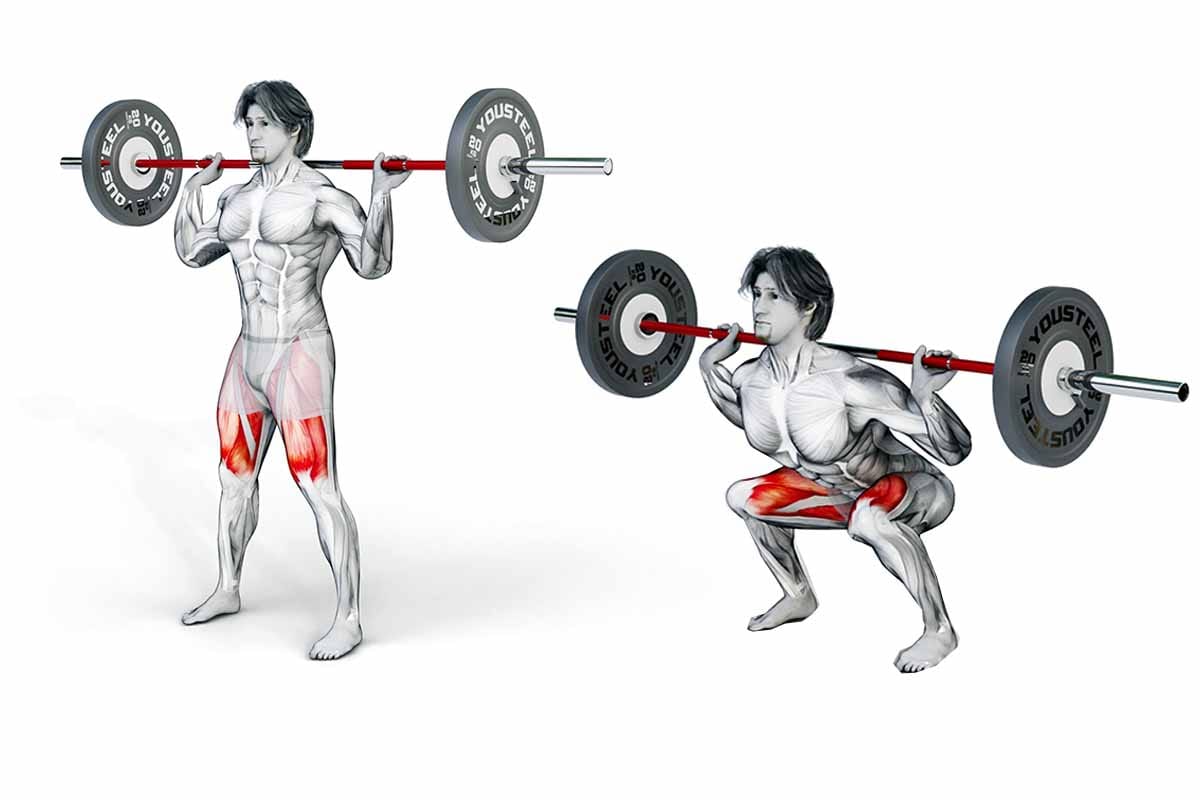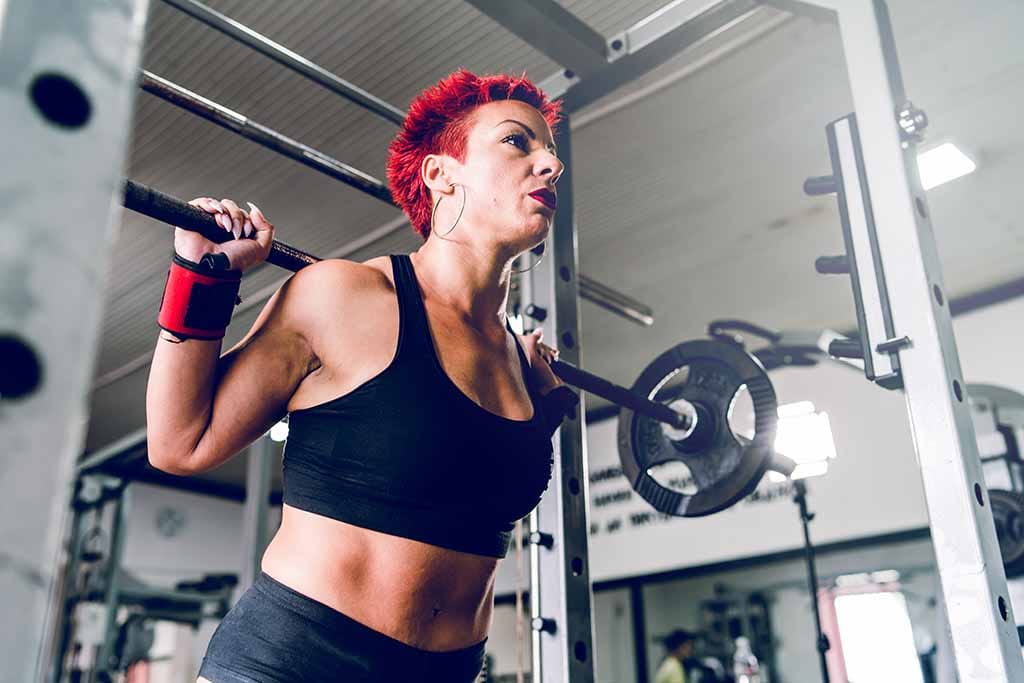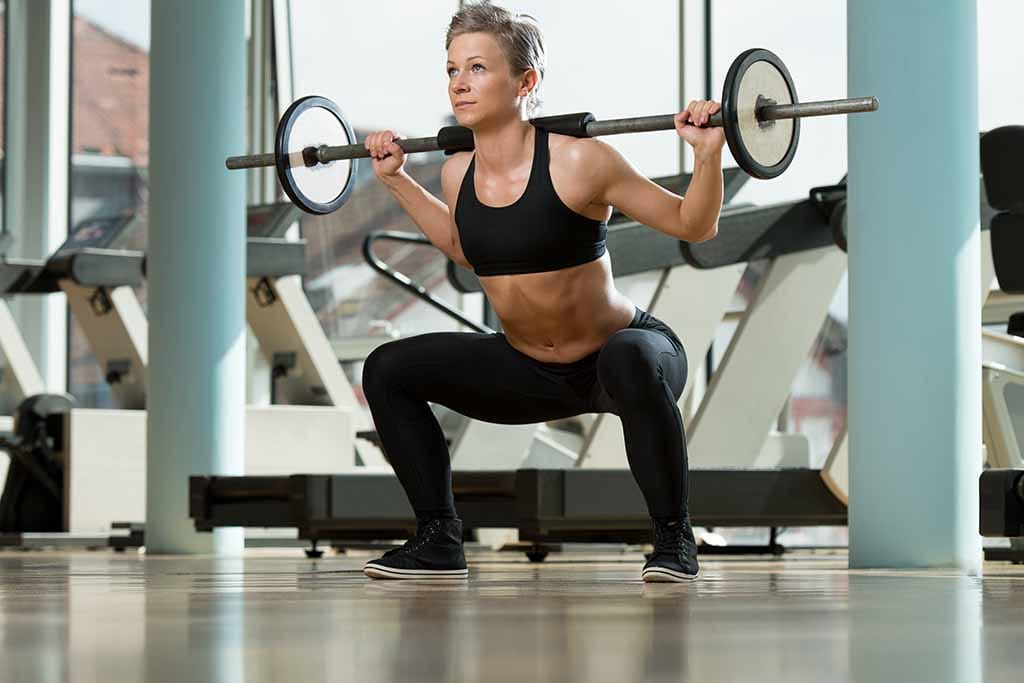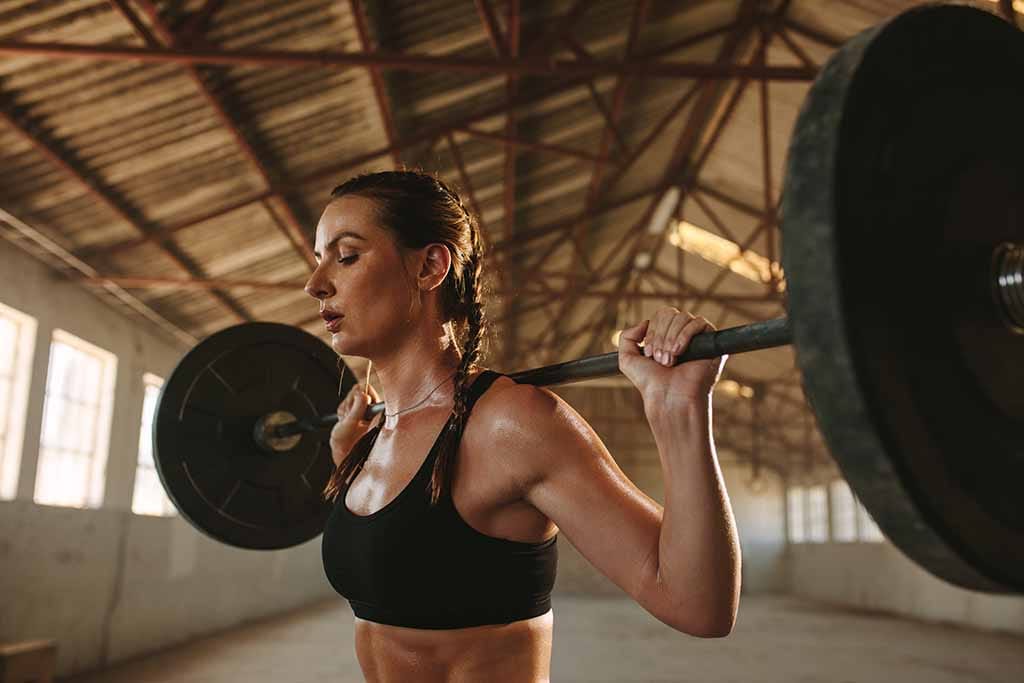High Bar vs. Low Bar Squat: What’s the Best Barbell Placement?
If you never skip a leg day, you know that many components go into perfecting your squat form.
For those who experience hip pain when squatting or lower back pain when squatting, you’re likely familiar with the importance of the small elements to tweak in your squat like foot placement and torso positioning.
Today, we’ll talk about the placement of your bar! See whether high bar vs. low bar squats are better for your training goals.
Find out which squat variation has more advantages that align with what you’re looking for, and get simple how-to video tutorials. We’ll also compare high bar vs. low bar squats across several key metrics to see how these two powerful leg sculpting exercises stack up against each other.
High Bar vs. Low Bar Squat Specifics
To begin, high bar and low bar squats are two common variations of the barbell back squat. The names are self-explanatory: in a high bar squat, your barbell sits higher across your shoulders, while a low bar squat has your barbell positioned lower down your back.
If you need a refresher on barbell back squats or other squat variations, check out these simple guides: Squats and Squat Progressions.
Each squat has distinct differences in bar placement, body mechanics, and muscle engagement.
Let’s get into a more detailed comparison of high bar vs. low bar squats.
High Bar Squat— Technique & Benefits
First, here’s a breakdown of the high bar squat in a few key categories:
Bar Placement:
- In a high bar squat, your barbell sits on the trapezius muscles just below your neck.
Body Mechanics:
- Position: Your torso stays more upright during the movement.
- Knee Alignment: Your knees travel further forward over the toes.
- Depth: It’s easier to hit a deeper squat. Usually, you can drop to below a parallel position with your thighs in a high bar squat.
- Stance: Typically, you use a narrower stance, with your feet around shoulder-width apart.
Muscle Emphasis:
- Quadriceps: Since your torso sits more upright and your knees flare outward slightly, the high bar squat mostly works your quadriceps (“quads”).
- Glutes and Hamstrings: These muscles are engaged but somewhat less than in the low bar squat.
- Core: You need strong core engagement to hold yourself upright.
Who Should Train with High Bar Squats?
- For people who train in Olympic weightlifting, the high bar squat is often used because it closely mimics the receiving position of a clean or snatch. To understand more about these lifting techniques, you can read Clean Pulls and Hang Snatch.
- It’s also used in general fitness and bodybuilding for quadriceps development. The high bar squat is probably the more common variation that you’ll see at the gym.
Low Bar Squat—Technique & Benefits
Now, let’s see how these specific categories apply to the low bar squat variation.
Bar Placement:
- Your barbell rests lower on the back, across the rear deltoids and just below the spine of the scapula (shoulder blades).
Body Mechanics:
- Position: You need to lean slightly forward.
- Knee Alignment: Your knees don’t travel as far forward. Instead, there’s more emphasis on moving your hips back, like sitting down in a chair.
- Depth: It may be harder to get as deep into a low bar squat as you would with high bar squats Nevertheless, you should still aim for parallel or below.
- Stance: Here, most prefer to use a wider stance to accommodate the extra hip movement.
Muscle Engagement:
- Glutes and Hamstrings: The backs of your legs work more heavily here because of the hip hinge and forward lean. This also works your hip flexors.
- Lower Back: Your lower back needs to apply more effort to keep the forward tilt of your torso and stabilize it.
- Quadriceps: Your quads still engage but are not as dominant as in your high bar squat.
Who Should Train with High Bar Squats?
- Sports-wise, high bar squats are favored in the powerlifting community. This is because they allow you to lift heavier weights by engaging more muscle groups and optimizing leverage.
- For overall strength training and posterior chain (rear body muscle) development, high bar squats are a good option.
How Do You Do High Bar vs. Low Bar Squats?
Considering the comparison guidelines above, take a look at this simple visual on how to perform your high bar vs. low bar squats.
Make sure to stretch your legs after a workout to avoid sore quads or injuries. Stay hydrated during your exercise, and try to consume a protein-rich snack no more than two hours after you lift.
What Muscles Do High vs. Low Bar Squats Work?
High bar and low bar squats essentially work the same muscles but in different capacities.
Each squat type puts a muscular emphasis on your legs and other muscles in a different way, which can be useful based on what you’re looking to develop.
High Bar Squat:

Primary Muscles Worked:
- Quadriceps:
Your quadriceps (“quads”) are the primary muscles targeted in high bar squats due to the more upright torso and greater knee flexion.
- Glutes:
The gluteal muscles (including the gluteus maximus, medius, and minimus) engage to extend your hips as you stand up from your squat. They’re less emphasized here compared to in a low bar squat.
Secondary Muscles Worked:
- Hamstrings:
Your hamstrings help stabilize your knee and hip joints but are less engaged in high bar squats than in low bar squats.
- Adductors:
The inner thigh muscles draw your thighs toward the midline of your body and also help stabilize your legs as you squat.
Stabilizer Muscles:
- Erector Spinae:
These muscles run along the spine and help you keep an upright posture.
- Core Muscles:
The rectus abdominis (six-pack) and obliques (waist muscles) help you brace your body in the air during a squat.
- Calves:
The gastrocnemius and soleus muscles help stabilize the lower leg and ankle. If you’re like many of us and have notoriously weak calves that are impeding your squat potential, check out some soleus exercises you can try to tone and strengthen the calves.
Low Bar Squat

Primary Muscles Worked:
- Glutes
The glutes are heavily engaged in low bar squats due to the hip hinge and forward lean, which emphasizes hip extension.
- Hamstrings
The hamstrings are more involved in low bar squats as they help control your descent and help with hip extension as you stand up.
Secondary Muscles Worked:
- Quadriceps
Your quads are still engaged but to a lesser extent compared to high bar squats since you flex your knees less.
- Adductors
Similarly to in your high bar squats, the adductors help stabilize the legs.
Stabilizer Muscles:
In terms of stability, your:
- Erector Spinae
- Core Muscles
- Calves
Perform largely the same function to keep your body stable, whether in a high vs. low bar squat.
Are High Bar or Low Bar Squats Better?
Image: A woman squats with a loaded barbell.

This entirely depends on your goals in fitness. As a form of posterior chain resistance training and to build overall strength, the low bar back squat may be more efficient.
On the other hand, high bar squats can be better if you’re training for stylized power moves like cleans and snatches that you see in Olympic lifting.
Take a look at this testimonial from Ryan Humiston, who added low bar squats to his consistent high bar squat routine.
For him, the low bar squat feels more similar in terms of muscular activity to a leg press. He also mentions the option to alternate between high bar and low bar squats weekly to vary your training.
High vs. Low Bar Squat Safety
Are high vs. low bar squats a safer option for your back and shoulders? Here are a few key safety considerations to make when you choose your squat.
Shoulder Position
The shoulder position in a low bar squat requires more shoulder mobility than some people are equipped with. This variation requires you to retract your shoulder blades (pull them together) more sharply than in a high bar squat.
If you don’t have good shoulder mobility, this variation may be dangerous, especially at heavier weights. Try to work with someone who understands how to spot a squat if you’re new to the low bar variation to avoid injury.
Weight Limit
Since you’re engaging the posterior chain and the glutes are kicking into overdrive, you may find that you can lift heavier weights in a low bar squat— even weights you may not be ready for technique-wise.
Going too heavy too quickly can, at best, tire you out, giving you the urge to nap after a workout. At worst, it can cause injuries. Always try to work your way up so you don’t jump the gun in terms of too much load.
Less Common
Regular gymgoers tend to practice high bar squats more often.
Why?
They probably see other lifters at the gym high bar squatting and tend to mimic the technique that seems more obvious or that other people like. It’s less common for you to see low bar squatting in many gyms.
For people who want to try this squat variation, it can mystify the mechanics of the low bar squat if you don’t see it often. Because of this, more people tend to use sloppy technique.
Let’s look at another possible way to work high vs. low bar squats into your workout routine.
High Bar vs. Low Bar Squats— Training Plan

When you break up your training schedule for the week and are planning out your squats, think about what you’re working towards in the gym. Your athletic or skills-based fitness goals are a good determining factor to see which squat bar placement is most suitable for you.
That being said, there’s no reason you can’t do both high bar and low bar squats.
Let’s say you’re on a training split like push-pull-legs. Here, you train your legs twice a week, which, for the purpose of this article, we can assume includes two opportunities to do squats.
If you’re working on back squats only, try a high bar squat for your first leg day and a low bar variation for your second.
This gives you a comprehensive approach to training your legs. If you want to use both squat styles, try to make sure you balance out your training in both styles.
Big Picture— High Bar vs. Low Bar Squats
To sum it up, there’s no “best option” to choose between high bar vs. low bar squats. As a reminder, high bar vs. low bar squats stack up like this across a few key metrics:
- Bar Placement: High Bar: On the upper traps. Low Bar: Across your rear delts and lower traps.
- Torso Position: High Bar: More upright. Low Bar: More forward.
- Muscle Emphasis: High Bar: Quad-dominant. Low Bar: Glute-, hamstring-, and lower back-dominant.
- Knees: High Bar: Knees move farther forward. Low Bar: Knees stay more in line with your toes.
- Stance: High Bar: Narrower stance. Low Bar: Wider stance.
Choosing Between High and Low Bar Squats
The ideal option for you between high bar and low bar squats depends on individual goals, body mechanics, and the specific demands of your sport or training program.
Which bar placement do you enjoy working with the most and do you feel you can consistently show up and work with on your leg days?
Ask yourself this question, and you’ve probably figured out which squat bar placement suits you best.
High bar squats are typically better for their emphasis on quad development and crossover to Olympic lifts. Low bar squats help you maximize strength and work your posterior chain.
Try both and log your sets and reps with the Flex Fitness app to see where you make the most progress. Happy squatting!
References
Kristiansen, E., Larsen, S., Haugen, M. E., Helms, E., & van den Tillaar, R. (2021). A Biomechanical Comparison of the Safety-Bar, High-Bar and Low-Bar Squat around the Sticking Region among Recreationally Resistance-Trained Men and Women. International journal of environmental research and public health, 18(16), 8351. https://doi.org/10.3390/ijerph18168351
Tataryn, N., Simas, V., Catterall, T., Furness, J., & Keogh, J. W. L. (2021). Posterior-Chain Resistance Training Compared to General Exercise and Walking Programmes for the Treatment of Chronic Low Back Pain in the General Population: A Systematic Review and Meta-Analysis. Sports medicine - open, 7(1), 17. https://doi.org/10.1186/s40798-021-00306-w
Related articles


Get fit with Flex
Build muscle & lose weight fast for free.
Available on iPhone + Apple Watch





